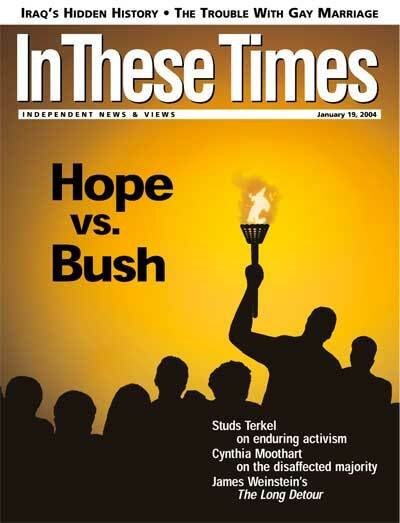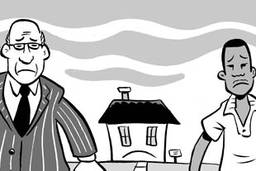
On the edge of the Chicago suburb of Barrington is a massive edifice known as a megachurch. Looking on the outside like a cross between a box store and a modern university building, Willow Creek Church presents the sort of decorous ugliness we expect of modern machines for worship. Inside, however, one may observe a true revolution in ecclesial design, for at the very heart of the building—in its nave, so to speak—is not a sanctuary but something more like a mall.
Its most striking element is a large food court that, even if it lacks the familiar brands we’d expect at a real mall, does a good job of looking the part. In a lofted concourse overlooking the food court is a Borders-like book and music store showcasing an impressive range of Christian literature. Attractive women can be seen perusing Christian guides to beauty or relationships. Fashion-conscious teens sift through bins of Christian rock and rap CDs. On one visit I bought a book of prayers for managers. (One prayer begins, “Lord, help me to understand that I can be replaced at any moment.”)
I sometimes drop in at Willow Creek’s very popular Saturday evening service for “seekers.” Seekers are what you might call skeptical but needy spiritual shoppers. One seeker service I attended began with a A Prairie Home Companion-style skit. A fully amplified pop band was on hand to provide music, which turned out to be a click or two higher on the brow than the usual charismatic Christian repertoire. A sermon followed, in which sin was not mentioned. Instead, the minister, a tanned and well-spoken fellow, preached about how all relationships are prone to failure—all relationships except for that special, personal one we’re called to enjoy with Jesus Christ. The crowd was full of singletons, mostly thirtysomething, more or less attractive, and apparently prosperous. The scene suggested, if not market research, sharp business acumen at work.
I won’t say Willow Creek is an affront to the God of Moses and Saint Paul. But the place does test the limits of pastiche. The more conventional believer likely will find it tacky. The skeptic of creeds will invariably find it funny. The semiotician will wonder if it is a gift of divine providence.
But the most important measure by which to judge Willow Creek? The church is popular. The food court and auditoriums bustle, the cash registers ring and the county has to send sheriff’s deputies to control traffic.
This is what good design gets you, Virginia Postrel argues in her new book, The Substance of Style: How the Rise of Aesthetic Value is Remaking Commerce, Culture, and Consciousness. Postrel, editor of Reason, believes we live in a “new age of aesthetics,” in which everyday life is increasingly being assimilated into the domain of “design.” We are familiar with the ways design transforms objects from commodities into talismans of comfort and delight. For nearly a century, style has made inroads into areas “where function used to stand alone.” But we no longer design just things, Postrel observes. We’ve begun designing environments and ourselves. It’s human nature to do so, the consequence of a need that is almost biological. We love variety and decoration, stimulation and pleasure—as ends in themselves. We humans have little vacant spaces in our natures, and well-designed objects fit right in with a click.
It is up to the engineers of desire to make these connections for us, for “aesthetics has become too important to be left to the aesthetes.” Which is to say, something separates the aesthetes from the rest of us. They want ideals; we want malls. What’s true for church design is true for cosmetology and town planning: Give the people what they want and they will cause traffic jams outside your parking lot. There’s no question that we, as a nation, want pleasure. “We”—and it’s always the democratic first-person plural with Postrel—“are demanding and creating an enticing, stimulating, diverse, and beautiful world.”
Americans don’t need convincing that it’s good to be turned on by consumer goods. So what explains Postrel’s apologia for pleasure? The clues come early on. “Decoration and adornment are neither higher nor lower than ‘real’ life,” she writes. “They are part of it.” Easy enough to agree with, but to the politically minded reader, the mention of “high and low” is a tip-off that liberals are about to come in for some bashing. “High,” as adepts of conservative-populist rhetoric understand, describes the exalted position in which liberals and other members of the left are supposed to hold their own tastes and opinions. “Low” corresponds to their opinion of the people. “Real life” is, for libertarians like Postrel, essentially the market.
Markets give the people what they want, Postrel maintains, and markets equal democracy. Still, she seems worried that resistance hampers the workings of this open system. A specter haunts our era of unfolding consumer liberation—a nefarious psychic force that corresponds in the libertarian mind to what leftists call false consciousness. I refer to critics of consumer culture, to be precise, bent on making people feel frivolous or grasping for coveting things in shop windows and catalogs. Several lines of luxury toilet brush may find a brisk market; homeowners who never so much as boil water may snap up expensive Viking ranges. But, Postrel laments, these pleasures are had at the risk of censure.
The problem with critics is that they demand the meaning of things, ascribe motives and attitudes. They wield concepts such as authenticity like “a rhetorical club to enforce [their own] taste.” Critics can be fools and snobs, and to prove it Postrel summons an All-Star team of killjoys, tendentiously glossed and selectively quoted. Walter Benjamin and Theodor Adorno, Vance Packard and Stewart Ewen show up on cue to denounce jazz and cluck at colored telephones. They “sniff” and “recoil,” get “disturbed” and even “perturbed.” They remind the author of preachers. They can even be racist and totalitarian, qualities Postrel assigns to the modernist architect Adolf Loos, author of the 1908 essay “Ornament and Crime.”
One point of all this critic-bashing is to establish that taste is an undecidable issue. Give a city planning board far-reaching responsibility, and what you’ll get is “assertions of raw power, reflecting personal quirks rather than predictable rules.” Rules about how big your garage door can be or how many trees you have to plant around your parking lot. To involve cultural authorities is inevitably to make a mess of things, so we’re better off leaving questions of taste to the market.
There is further point to attacking critical authority as well, for doing so makes it easier to free the commodity from its unsavory backstory, leaving only its alluring appearance. Postrel grows indignant, for example, at the notion that marketers might deceive or manipulate, that they “manufacture” desire and use stylistic innovation and obsolescence to accelerate sales turnover. Such critiques betray “a naïve mid-twentieth-century view of how business operates.” It’s as if purveyors of things are omnipotent and we’re all dopes.
Naiveté is not a charge Postrel should bandy about. Her theory of aesthetics has all the persuasive force of “We report, you decide.” The world of goods is not part of a social system of exploitation, as some critics like to suggest. For Postrel it is a dynamic field of “aesthetic discovery” driven by “individual action, individual creativity, and individual desire.” We do not consume to assuage our discontent, we consume things, luxury items even, for their own sake. We do use objects and styles to help “construct our identities,” but not necessarily with unpleasant motives like status display in mind, as critics tend to presume. Critics, in fact, need to chill out. Sometimes a Lexus is just a Lexus.
One can sympathize with Postrel even while finding her aesthetic theorizing vapid. Steadfastly resisting the amorous glances of the commodity form has its own psychic costs. Even the most stringent critic will let himself be deluded a little, and sometimes work the system for his own ends. Moreover, we can share Postrel’s admiration of the design profession, despite its occasional pretensions. Like the Salvation Army, it tries to brighten a dingy world. Besides, it seems to be working on its own esteem issues. “It will take time for people to realize,” a member of the profession tells Postrel, “that creating the difference between Coke and Pepsi is not just an empty pastime but one of the many signs of life in a free society.”
May God preserve our freedom. But forget Coke and Pepsi. I’m interested in what constellation of desire and creativity called for the old-school tomato—as rare these days as an apple pie actually cooked by “mom”—to be replaced by the spherule of engineered pink pith in every grocery and restaurant? Why are our dream houses built so poorly? Why does our television news suck? And our health care system? Why do the freedom and choice promised by the market so often turn out to be their opposites?
Where does the imperious customer stand on these questions? He gives no indication, it seems. Perhaps he’s too preoccupied in keeping his place in our engineered world. After all, he knows he can be replaced at any moment. He has it on the highest authority.
Its most striking element is a large food court that, even if it lacks the familiar brands we’d expect at a real mall, does a good job of looking the part. In a lofted concourse overlooking the food court is a Borders-like book and music store showcasing an impressive range of Christian literature. Attractive women can be seen perusing Christian guides to beauty or relationships. Fashion-conscious teens sift through bins of Christian rock and rap CDs. On one visit I bought a book of prayers for managers. (One prayer begins, “Lord, help me to understand that I can be replaced at any moment.”)
I sometimes drop in at Willow Creek’s very popular Saturday evening service for “seekers.” Seekers are what you might call skeptical but needy spiritual shoppers. One seeker service I attended began with a A Prairie Home Companion-style skit. A fully amplified pop band was on hand to provide music, which turned out to be a click or two higher on the brow than the usual charismatic Christian repertoire. A sermon followed, in which sin was not mentioned. Instead, the minister, a tanned and well-spoken fellow, preached about how all relationships are prone to failure—all relationships except for that special, personal one we’re called to enjoy with Jesus Christ. The crowd was full of singletons, mostly thirtysomething, more or less attractive, and apparently prosperous. The scene suggested, if not market research, sharp business acumen at work.
I won’t say Willow Creek is an affront to the God of Moses and Saint Paul. But the place does test the limits of pastiche. The more conventional believer likely will find it tacky. The skeptic of creeds will invariably find it funny. The semiotician will wonder if it is a gift of divine providence.
But the most important measure by which to judge Willow Creek? The church is popular. The food court and auditoriums bustle, the cash registers ring and the county has to send sheriff’s deputies to control traffic.
This is what good design gets you, Virginia Postrel argues in her new book, The Substance of Style: How the Rise of Aesthetic Value is Remaking Commerce, Culture, and Consciousness. Postrel, editor of Reason, believes we live in a “new age of aesthetics,” in which everyday life is increasingly being assimilated into the domain of “design.” We are familiar with the ways design transforms objects from commodities into talismans of comfort and delight. For nearly a century, style has made inroads into areas “where function used to stand alone.” But we no longer design just things, Postrel observes. We’ve begun designing environments and ourselves. It’s human nature to do so, the consequence of a need that is almost biological. We love variety and decoration, stimulation and pleasure—as ends in themselves. We humans have little vacant spaces in our natures, and well-designed objects fit right in with a click.
It is up to the engineers of desire to make these connections for us, for “aesthetics has become too important to be left to the aesthetes.” Which is to say, something separates the aesthetes from the rest of us. They want ideals; we want malls. What’s true for church design is true for cosmetology and town planning: Give the people what they want and they will cause traffic jams outside your parking lot. There’s no question that we, as a nation, want pleasure. “We”—and it’s always the democratic first-person plural with Postrel—“are demanding and creating an enticing, stimulating, diverse, and beautiful world.”
We want our vacuum cleaners and mobile phones to sparkle, our bathroom faucets and desk accessories to express our personalities. We expect every strip mall and city block to offer designer coffee, several cuisines, a copy shop with do-it-yourself graphics workstations, and a nail salon for manicures on demand. We demand trees in our parking lots, peaked roofs and decorative facades on our supermarkets, auto dealerships as swoopy and stylish as the cars they sell.Better and more alluring products “add value,” Postrel maintains, in ways that conventional economic analysis has yet to understand. Even the simplest, most meaningless of surfaces can work a sort of magic. Postrel describes how Motorola discovered that customers would pay a hefty premium to buy a pager encased in squirt gun-green plastic, even though market research showed they were unwilling to pay more for a pager with mere technological upgrades.
Americans don’t need convincing that it’s good to be turned on by consumer goods. So what explains Postrel’s apologia for pleasure? The clues come early on. “Decoration and adornment are neither higher nor lower than ‘real’ life,” she writes. “They are part of it.” Easy enough to agree with, but to the politically minded reader, the mention of “high and low” is a tip-off that liberals are about to come in for some bashing. “High,” as adepts of conservative-populist rhetoric understand, describes the exalted position in which liberals and other members of the left are supposed to hold their own tastes and opinions. “Low” corresponds to their opinion of the people. “Real life” is, for libertarians like Postrel, essentially the market.
Markets give the people what they want, Postrel maintains, and markets equal democracy. Still, she seems worried that resistance hampers the workings of this open system. A specter haunts our era of unfolding consumer liberation—a nefarious psychic force that corresponds in the libertarian mind to what leftists call false consciousness. I refer to critics of consumer culture, to be precise, bent on making people feel frivolous or grasping for coveting things in shop windows and catalogs. Several lines of luxury toilet brush may find a brisk market; homeowners who never so much as boil water may snap up expensive Viking ranges. But, Postrel laments, these pleasures are had at the risk of censure.
The problem with critics is that they demand the meaning of things, ascribe motives and attitudes. They wield concepts such as authenticity like “a rhetorical club to enforce [their own] taste.” Critics can be fools and snobs, and to prove it Postrel summons an All-Star team of killjoys, tendentiously glossed and selectively quoted. Walter Benjamin and Theodor Adorno, Vance Packard and Stewart Ewen show up on cue to denounce jazz and cluck at colored telephones. They “sniff” and “recoil,” get “disturbed” and even “perturbed.” They remind the author of preachers. They can even be racist and totalitarian, qualities Postrel assigns to the modernist architect Adolf Loos, author of the 1908 essay “Ornament and Crime.”
One point of all this critic-bashing is to establish that taste is an undecidable issue. Give a city planning board far-reaching responsibility, and what you’ll get is “assertions of raw power, reflecting personal quirks rather than predictable rules.” Rules about how big your garage door can be or how many trees you have to plant around your parking lot. To involve cultural authorities is inevitably to make a mess of things, so we’re better off leaving questions of taste to the market.
There is further point to attacking critical authority as well, for doing so makes it easier to free the commodity from its unsavory backstory, leaving only its alluring appearance. Postrel grows indignant, for example, at the notion that marketers might deceive or manipulate, that they “manufacture” desire and use stylistic innovation and obsolescence to accelerate sales turnover. Such critiques betray “a naïve mid-twentieth-century view of how business operates.” It’s as if purveyors of things are omnipotent and we’re all dopes.
Naiveté is not a charge Postrel should bandy about. Her theory of aesthetics has all the persuasive force of “We report, you decide.” The world of goods is not part of a social system of exploitation, as some critics like to suggest. For Postrel it is a dynamic field of “aesthetic discovery” driven by “individual action, individual creativity, and individual desire.” We do not consume to assuage our discontent, we consume things, luxury items even, for their own sake. We do use objects and styles to help “construct our identities,” but not necessarily with unpleasant motives like status display in mind, as critics tend to presume. Critics, in fact, need to chill out. Sometimes a Lexus is just a Lexus.
One can sympathize with Postrel even while finding her aesthetic theorizing vapid. Steadfastly resisting the amorous glances of the commodity form has its own psychic costs. Even the most stringent critic will let himself be deluded a little, and sometimes work the system for his own ends. Moreover, we can share Postrel’s admiration of the design profession, despite its occasional pretensions. Like the Salvation Army, it tries to brighten a dingy world. Besides, it seems to be working on its own esteem issues. “It will take time for people to realize,” a member of the profession tells Postrel, “that creating the difference between Coke and Pepsi is not just an empty pastime but one of the many signs of life in a free society.”
May God preserve our freedom. But forget Coke and Pepsi. I’m interested in what constellation of desire and creativity called for the old-school tomato—as rare these days as an apple pie actually cooked by “mom”—to be replaced by the spherule of engineered pink pith in every grocery and restaurant? Why are our dream houses built so poorly? Why does our television news suck? And our health care system? Why do the freedom and choice promised by the market so often turn out to be their opposites?
Where does the imperious customer stand on these questions? He gives no indication, it seems. Perhaps he’s too preoccupied in keeping his place in our engineered world. After all, he knows he can be replaced at any moment. He has it on the highest authority.
Dave Mulcahey, a former managing editor of The Baffler, wrote In These Times’ monthly “Appallo-o-meter” feature for nearly 10 years, until the fall of 2009.







